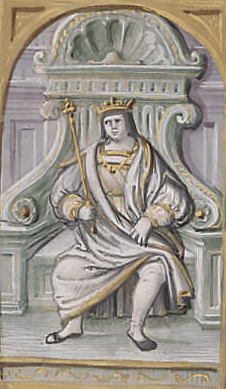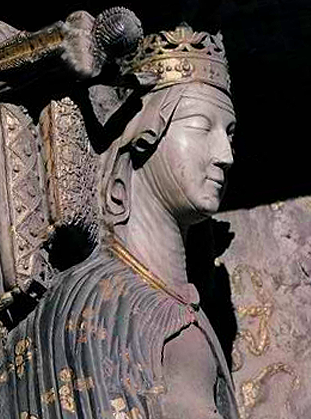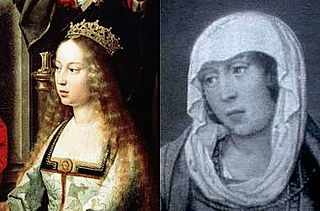Related Research Articles

Afonso IV, called the Brave, was King of Portugal from 1325 until his death in 1357. He was the only legitimate son of King Denis of Portugal and Elizabeth of Aragon.

Afonso V, known by the sobriquet the African, was king of Portugal from 1438 until his death in 1481, with a brief interruption in 1477. His sobriquet refers to his military conquests in Northern Africa.

John I was King of Castile and León from 1379 until 1390. He was the son of Henry II and of his wife Juana Manuel of Castile.

John I, also called John of Aviz, was King of Portugal from 1385 until his death in 1433. He is recognized chiefly for his role in Portugal's victory in a succession war with Castile, preserving his country's independence and establishing the Aviz dynasty on the Portuguese throne. His long reign of 48 years, the most extensive of all Portuguese monarchs, saw the beginning of Portugal's overseas expansion. John's well-remembered reign in his country earned him the epithet of Fond Memory ; he was also referred to as "the Good", sometimes "the Great", and more rarely, especially in Spain, as "the Bastard" (Bastardo).

Ferdinand I, sometimes called the Handsome or occasionally the Inconstant, was the King of Portugal from 1367 until his death in 1383. He was also briefly made King of Galicia, in 1369. Facing a lack of legitimate male heirs, his death led to the 1383–85 crisis, also known as the Portuguese interregnum.

Henry III of Castile, called the Suffering due to his ill health, was the son of John I and Eleanor of Aragon. He succeeded his father as King of Castile in 1390.

Peter I, called the Just or the Cruel, was King of Portugal from 1357 until his death. He was the third but only surviving son of Afonso IV of Portugal and his wife, Beatrice of Castile.

Beatrice was the only surviving legitimate child of King Ferdinand I of Portugal and his wife, Leonor Teles. She became Queen consort of Castile by marriage to King John I of Castile. Following her father's death without a legitimate male heir, she claimed the Portuguese throne, but lost her claim to her uncle, who became King John I of Portugal, founder of the House of Aviz.

The Battle of Aljubarrota was fought between the Kingdom of Portugal and the Crown of Castile on 14 August 1385. Forces commanded by King John I of Portugal and his general Nuno Álvares Pereira, with the support of English allies, opposed the army of King John I of Castile with its Aragonese and French allies, as well as Genoese mercenaries at São Jorge, between the towns of Leiria and Alcobaça, in central Portugal. The result was a decisive victory for the Portuguese, ruling out Castilian ambitions to the Portuguese throne, ending the 1383–85 Crisis and assuring John as King of Portugal.

The 1383–1385 Portuguese interregnum was a civil war in Portuguese history during which no crowned king of Portugal reigned. The interregnum began when King Ferdinand I died without a male heir and ended when King John I was crowned in 1385 after his victory during the Battle of Aljubarrota.

Catherine of Lancaster was Queen of Castile by marriage to King Henry III of Castile. She governed Castile as regent from 1406 until 1418 during the minority of her son.

João das Regras, in English, literally John of the Rules, was a Portuguese jurist of the second half of the 14th century. In the context of the 1383—1385 Crisis, in Portugal, he stood out for his masterly representation for the cause of the Master of Avis in the Coimbra Courts of 1385, the corollary of which was his acclaim as King of Portugal.

The War of the Castilian Succession was the military conflict contested from 1475 to 1479 for the succession of the Crown of Castile fought between the supporters of Joanna 'la Beltraneja', reputed daughter of the late monarch Henry IV of Castile, and those of Henry's half-sister, Isabella, who was ultimately successful.

Leonor Teles was queen consort of Portugal by marriage to King Ferdinand I, and regent of Portugal. She was one of the protagonists, along with her brothers and her daughter Beatrice, of the events that led to the succession crisis of 1383–1385, which culminated in the defeat of her son-in-law King John I of Castile and his armies in the Battle of Aljubarrota. Called "the Treacherous" by her subjects, who execrated her on account of her adultery and treason to her native country, she was dubbed by historian Alexandre Herculano as "the Portuguese Lucrezia Borgia".
In the Medieval Kingdom of Portugal, the Cortes was an assembly of representatives of the estates of the realm – the nobility, clergy and bourgeoisie. It was called and dismissed by the King of Portugal at will, at a place of his choosing. Cortes which brought all three estates together are sometimes distinguished as Cortes-Gerais, in contrast to smaller assemblies which brought only one or two estates, to negotiate a specific point relevant only to them.

The naval Battle of Saltes Island or Battle of Saltes took place on 17 July 1381, off Saltes Island, between the Crown of Castile and the Kingdom of Portugal during the Third Ferdinand War. The Castilian fleet commanded by Don Fernando Sánchez de Tovar defeated decisively the Portuguese fleet led by João Afonso Telo. The result of the battle was the destruction of the naval offensive capability of Portugal, achieving the Castilian naval supremacy in the Atlantic Ocean.

The Third Fernandine War was the last conflict of the Fernandine Wars, and took place between 1381–1382, between the Crown of Castile and the Kingdoms of Portugal and England. When Henry II of Castile died in 1379, John of Gaunt, 1st Duke of Lancaster claimed their rights of the throne of the Kingdom of Castile, and found an ally Ferdinand I of Portugal.

The siege of Algeciras was a battle of the Spanish Reconquista that occurred between July 1309 and January 1310. The battle was fought between the forces of the Kingdom of Castile, commanded by King Ferdinand IV of Castile and his vassals, and the Emirate of Granada commanded by Sultan Abu'l-Juyush Nasr. The battle resulted in a humiliating defeat for the Kingdom of Castile whose army was obliged to lift the siege due to the atrocious conditions of life in the Castilian camp and the desertion of Infante John of Castile. The battle marked one of the many battles fought at Algeciras where the Christian forces would try to take the city unsuccessfully from the Muslims.

The Kingdom of Portugal was established from the county of Portugal in the 1130s, ruled by the Portuguese House of Burgundy. During most of the 12th and 13th centuries, its history is chiefly that of the gradual reconquest of territory from the various Muslim principalities (taifas) of the period.
Alfonso Enríquez, Count of Noreña and of Gijón and lord of several places, was the eldest son of King Henry II of Castile and Elvira Íñiguez born before the king's marriage. As one of the most powerful feudal lords in Asturias, where he owned many properties, he attempted to declare the independence of this region from his brother King John I and then from his nephew, King Henry III of Castile. He and his Portuguese wife, Isabel of Portugal, a natural daughter of King Ferdinand I, are the ancestors of the Noronha lineage in Portugal.